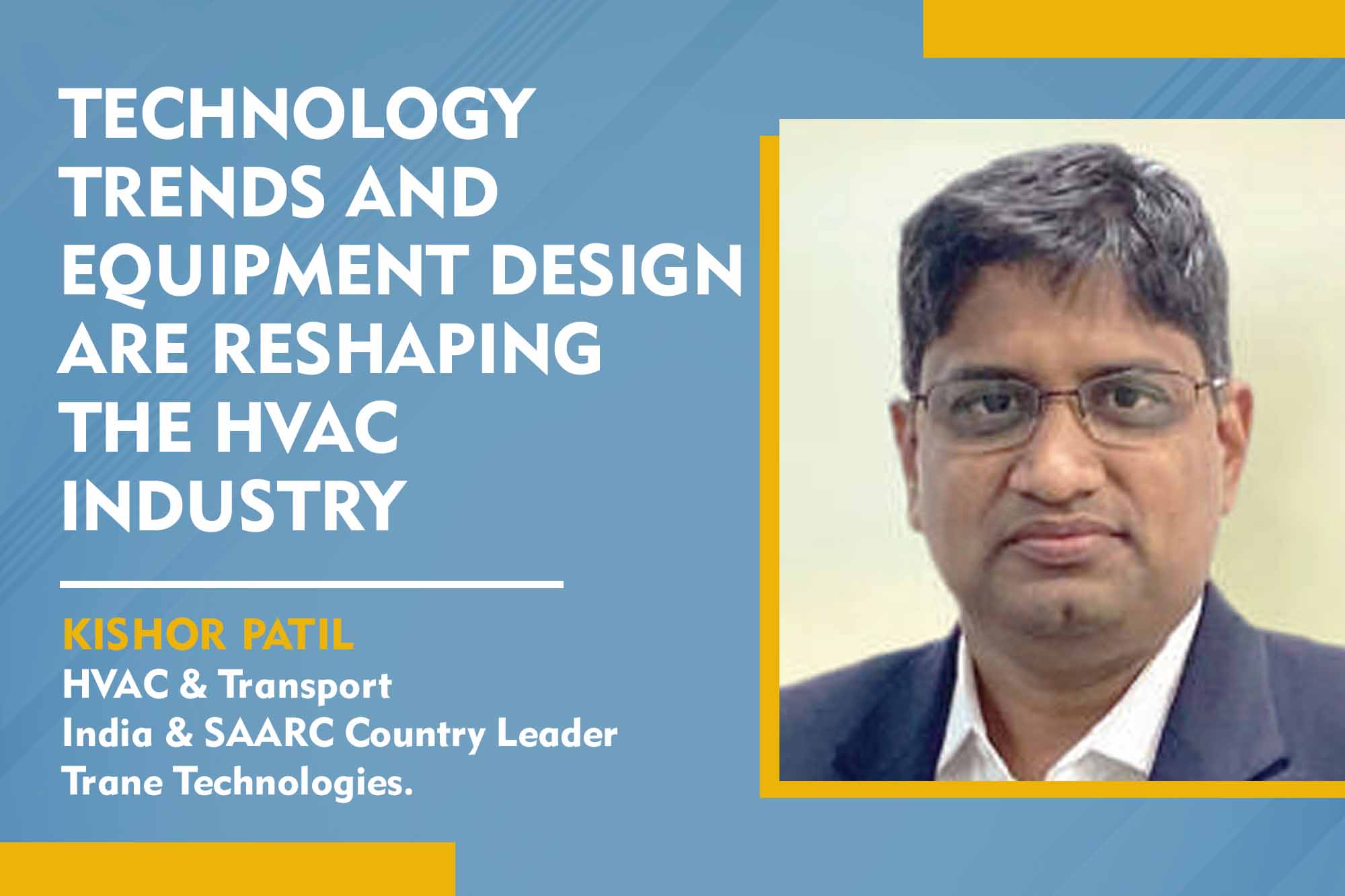Kishor Patil, HVAC & Transport, India & SAARC Country Leader, Trane Technologies, says advancements in variable-speed compressors are revolutionising energy efficiency in HVACR technologies. By dynamically adjusting their speed, these compressors offer precise control over cooling or heating, driving significant improvements across the sector.
How are variable-speed compressors contributing to energy efficiency in the HVACR industry?
Recent advancements in variable-speed compressors are driving significant improvements in energy efficiency across HVACR technologies. These compressors, which adjust their speed based on demand, offer precise control over cooling or heating output, driving significant improvements in energy efficiency within the HVACR sector. The latest developments in this field encompass several key areas.
Continuing research focuses on improving control algorithms for variable-speed compressors, aiming to optimise their performance. These algorithms consider factors such as load demands, ambient conditions, and system needs to achieve maximum energy efficiency without compromising comfort levels.
Furthermore, variable-speed compressors are increasingly integrated into intelligent HVAC systems. These systems utilise advanced sensors and analytics to dynamically adjust compressor operations based on real-time factors such as occupancy trends and weather predictions. This integration improves energy efficiency by optimising system performance in response to changing conditions.
Furthermore, advancements in motor technologies play a crucial role in improving the performance of variable-speed compressors. High-efficiency permanent magnet motors provide superior power density and efficiency when compared to conventional motor designs, thereby enhancing the overall efficiency of the system. The new latest screw compressor design with Variable Volume Index (Variable Vi) allows the equipment to operate at the most appropriate pressure ratio to reach remarkable efficiency levels. The compressors are also equipped with a permanent magnet motor, and this feature further enhances efficiency levels across the load curve of the compressor.
Variable Refrigerant Flow (VRF) systems, which utilise variable-speed compressors, continue to evolve with improved designs and features. These systems offer zoning capabilities and enhanced efficiency through features like improved heat exchangers and compressor modulation techniques. Inverter-driven compressors, a subtype of variable-speed compressors, are increasingly prevalent in residential and commercial HVACR applications. These compressors use electronic inverters to control motor speed, enabling seamless modulation and precise capacity matching.
Additionally, ongoing efforts in research and development focus on heat pump applications, where variable-speed compressors are widely used for heating and cooling purposes. These efforts aim to enhance the performance and reliability of variable-speed compressors in heat pump systems. The energy efficiency regulations and standards continue to shape advancements in variable-speed compressor technology by setting targets and encouraging innovation. These regulations drive the industry towards more sustainable and efficient HVACR solutions.
Conclusively, the latest advancements in variable-speed compressors aim to improve energy efficiency, reliability, and comfort in HVACR technologies. These developments contribute to sustainability goals and reduce operating costs for end-users. For the most recent updates, consulting industry publications, manufacturer websites, and research articles are recommended.
Please discuss innovative methods in HVAC and equipment design aimed at promoting efficiency in building practices.
Innovative HVAC&R equipment designs are crucial for efficient buildings. One promising solution is the implementation of full electrification for HVAC systems. Full electrification of HVAC systems in India is an ambitious goal that aligns with broader efforts to reduce carbon emissions and combat climate change. The Indian government has shown a commitment to promoting energy efficiency and renewable energy adoption, which aligns with the goals of HVAC electrification. Initiatives such as the UJALA scheme (Unnat Jyoti by Affordable LEDs for All), the Energy Conservation Building Code (ECBC), and the National Solar Mission are steps in this direction. China, on the other hand already has successful cases for full electrification HVAC solutions. This solution is in trend and has helped significantly reduce fossil fuel consumption and CO2 emissions while enhancing energy efficiency.
How are technological trends reshaping the HVAC industry?
IoT-enabled HVAC systems permit remote supervision and management, enhancing system efficiency and cutting down on operational expenses. Innovative startups are launching products that boost the performance of air conditioning and heat pump systems by monitoring essential metrics and providing instant control options.
As far as decarbonisation is concerned, there is a concerted effort to cut down carbon emissions universally, with technological advancements facilitating more eco-friendly products and methods. Within the HVAC industry, transitioning to low global warming potential (GWP) refrigerants continues to be one of the most effective decarbonisation activities globally. Also, a building’s overall “carbon emissions” actually means “carbon dioxide equivalent emissions” (CO2e), which includes refrigerants. Most common HFC refrigerants for heating and cooling emit gases that can have 1,000 to 9,000 times greater capacity to warm the atmosphere than carbon dioxide. Thus, next-generation refrigerants are a top strategy for drawing down global emissions.
In the context of digitalisation and remote monitoring, the adoption of IoT platforms, cloud analytics, and smartphone apps is revolutionising HVAC systems. By harnessing data analytics and machine learning, predictive maintenance systems can detect early signs of malfunctions or inefficiencies, enabling prompt servicing and upkeep. This method simplifies HVAC maintenance, minimises system downtime, improves the efficiency of the HVAC system, and prolongs the lifespan of the systems.
Advanced sensors, data analysis, and algorithms are utilised to achieve precise indoor climate control, tailoring conditions to individual preferences and maintaining consistent comfort levels for occupants. This innovative approach ensures a pleasant environment and maximises energy efficiency by optimising heating, ventilation, and air conditioning (HVAC) systems.
Anticipated regulatory changes, such as the transition to low GWP refrigerants and new production standards for equipment to reduce global warming potential (GWP), are prompting the industry for quick adaptation. This includes accelerating India’s national strategy to phase down Hydrofluorocarbons (HFCs) and advocating the application of next-generation low-GWP HFO refrigerants as replacements.
Cookie Consent
We use cookies to personalize your experience. By continuing to visit this website you agree to our Terms & Conditions, Privacy Policy and Cookie Policy.

















